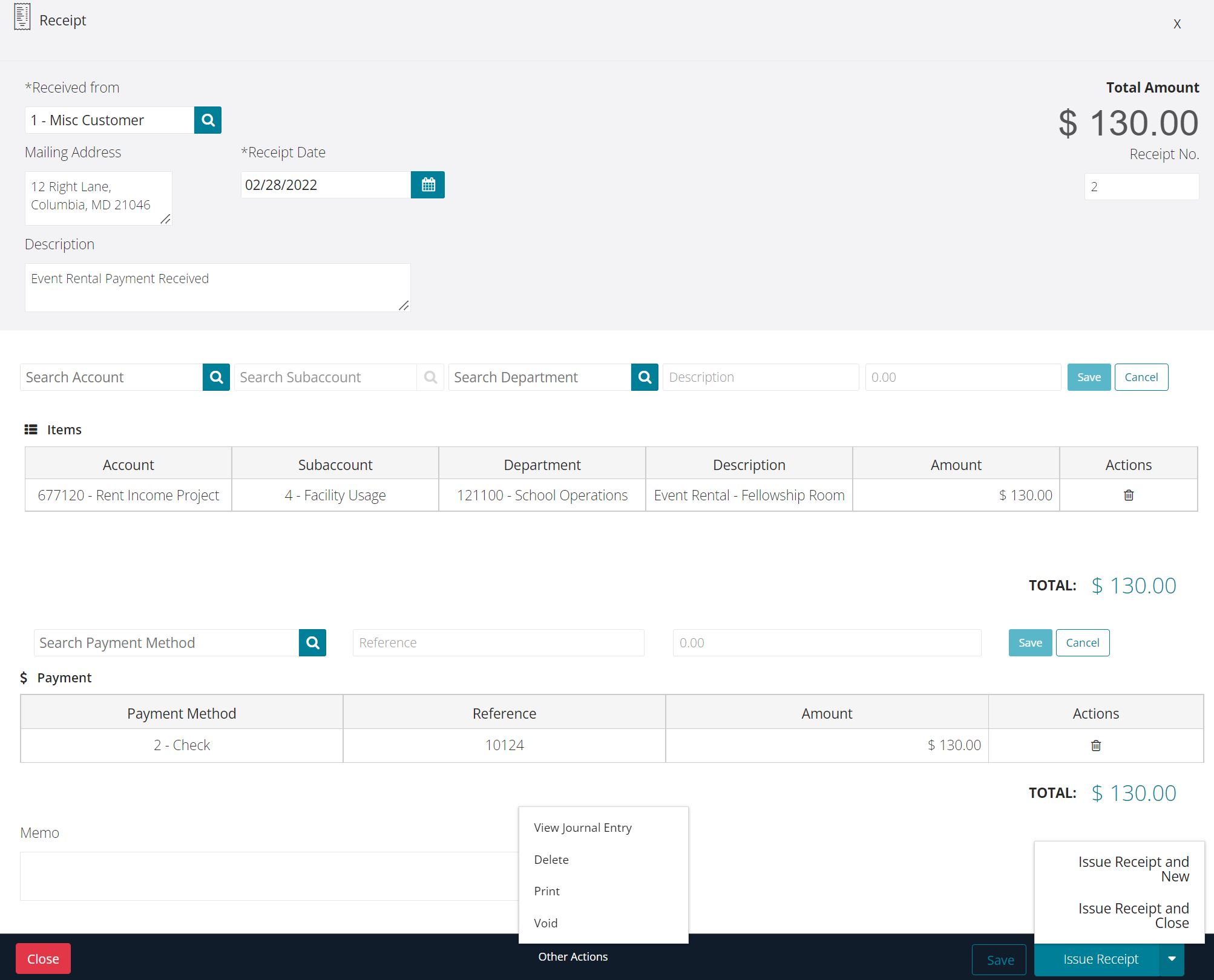In Receipt Management you can Receive Payment which correlates directly to receivables or receivable credits in Payable and Receivable or you can Receive Money which is used when you are not issuing invoices through payable and receivable. Both processes will provide a receipt that is issued to the payee and then those receipts can be selected and grouped together in the Banking Transaction Make Deposit screen to post the deposit entry to the bank.

The pencil icon under the Actions column for each of the entries can be used to reopen each screen and this allows us to view, edit (as long as the entry is not finalized), or use the Other Actions menu (within each screen) to print the journal entry, void, or use the other menu options that are available after an entry is finalized.

In the filter menu, you can set a Date, search by Reference Code, Received From, Status (All, Open, Issued, Void), and Amount. The clear button will remove any recent selection made in the filter fields and the apply button will run the search including any changes made to the filter and display any findings in the grid view.

You can print or download a list of receipt entries using the printer or excel icons on the right above the grid view. This will print or download only the entries displayed on the grid view.

The grid view will by default display the first 15 entries and any additional entries will display in separate pages. There is a count for how many entries/items are available and how many are being displayed on the page out of those available. The arrows can be used to move between the pages.
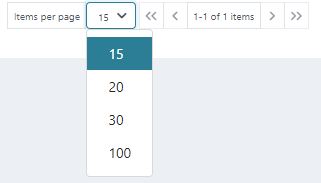
In Receive Payment we can process payments received for receivables and receivable credits, and issue receipts.
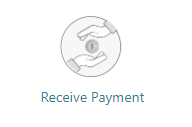
We will select the Billing Subaccount, Received From (from a list of Customer, Employee, and Entity), populate the Date (this will be the transaction and Receipt Date), populate a Mailing Address (this address will print on the receipt), and Description. The Receipt No. on the right side will auto populate for us when the payment is received and can be left blank, but we can also override this field to change the receipt number. There is an option for Manual Allocate and this can be selected to enable the Pending Transactions and Credit section, and this will allows us to allocate the payment we are receipting to any invoices and/or credits. We will see displayed a “Summary” with Total Charges, Total Credits, and Total Due, and this will update as we make selections in Pending Transactions and Credits.

In the Pending Transactions section below we can select from the list of receivables, and we can select any receivable credits from the Credit section. For every transaction in Pending Transactions and Credits, there is a reference Code, Description, Invoice Date, Due Date, Original Amount, Open Balance, and Payment. The Original Amount is the initial amount for the transaction, the Open Balance amount is the remaining amount for the transaction that is still due and will update after every received payment, and the Payment amount is editable and we can double click in that field and type in the amount that we are receiving towards that transaction. The Payment field allows us to receive full payments towards an invoice or to receive partial payments. Each section will total up the amount of the entries we have selected as “Total Selected”. In the Payment section we will record the payment method used to receive payment and this section can have one or multiple payments but the Total Selected for this section will need to match the Amount Received at the top of the screen before we are able to finalize our receipt. In the Payment section we will select the payment method (from Cash, Check, Electronic, Other), populate the Reference (check number for example), select the Tax Deductible box (only if applicable for donations and for churches, donations are expected to be processed through the weekly donation process), and amount. The Save button after the amount saves the payment entry and Cancel will clear it. Once the payment entry is saved, there is a trash bin icon under the Actions column to delete the payment information. There is a Memo field towards the bottom of the screen that can be used to add an additional note. The “Receive Payment and Close” button will save the payment received and issue a receipt, close the receive payment screen, and take us back into the main Receipt Management screen and the receivable and receivable credit should now display as “Paid” in the Payable and Receivable screen, also a receipt entry will be created and will be available in the Make Deposit screen from “Banking Transaction“. The “Receive Payment” button will issue the payment but will leave the Receive Payment screen open for the current receipt. The “Close” button will close out of the Receive Payment screen, but the system will prompt us before closing if we are sure we want to close the current window. Once the receive payment is saved, the system will save the receipt information, make entries to clear the receivable balance for the subaccount (credit entry to the accounts receivable account), and internally it will make the appropriate offsetting debit entry on our behalf to a clearing account (102200-Receipt Clearing for example). Reference Transaction Config and see the Journal Entry example below. Below are also two examples of the Receive Payment screen without the Manual Allocate box selected and another with the Manual Allocate box selected.
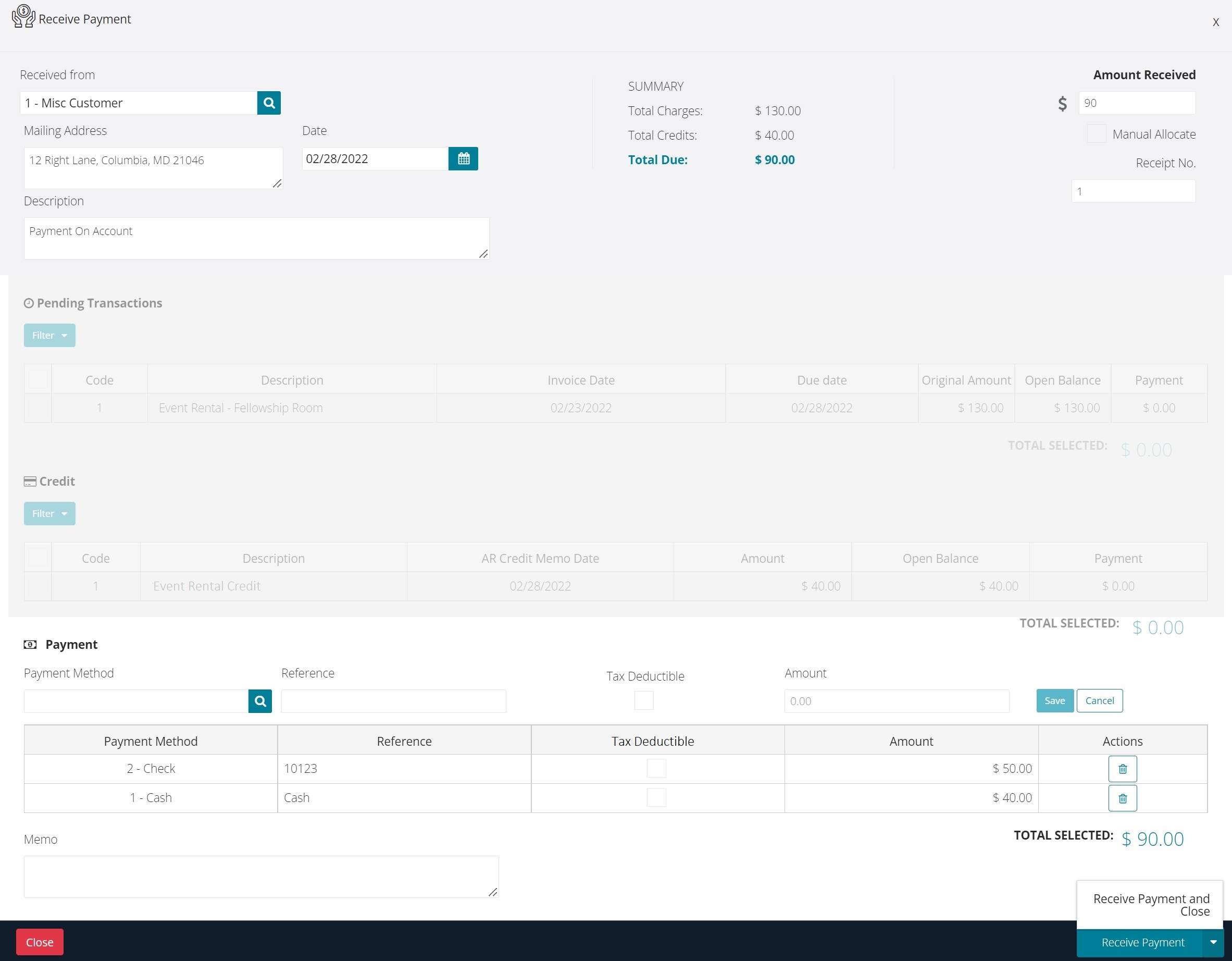
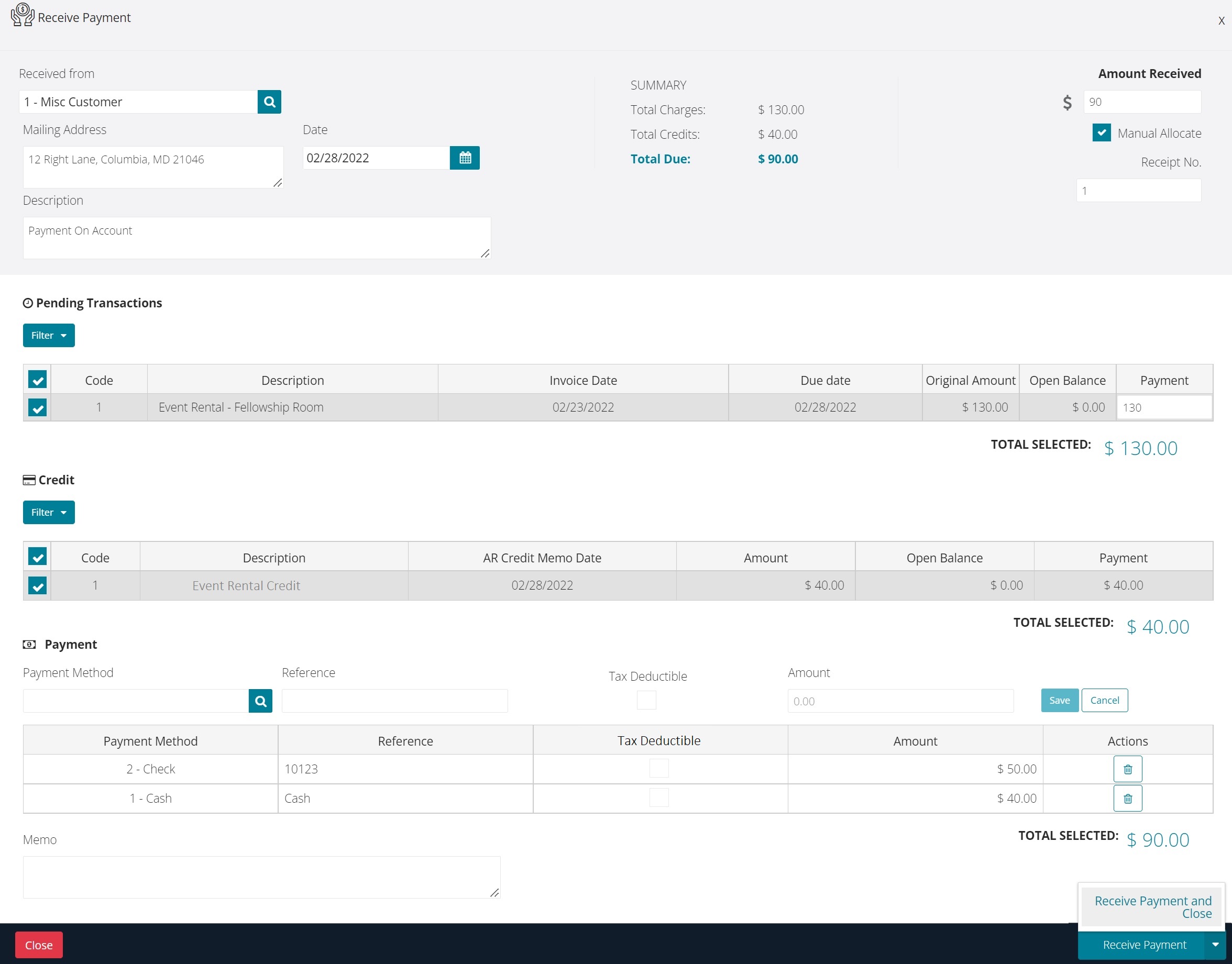
After payment is received, an “Other Actions” section will become available in the Received Payment screen, and this will allow us to View Journal Entry, Void, and Print. The View Journal Entry option will display the journal with the entries related to the receipt which are the debit to the receipt clearing account and credit to the accounts receivable account. The Void option will allow us to void the receipt and will create additional entries for us to void, which will credit back into the receipt clearing account and debit the payment received amount back into the accounts receivable account. The Print option will print a document for the received payment (receipt).


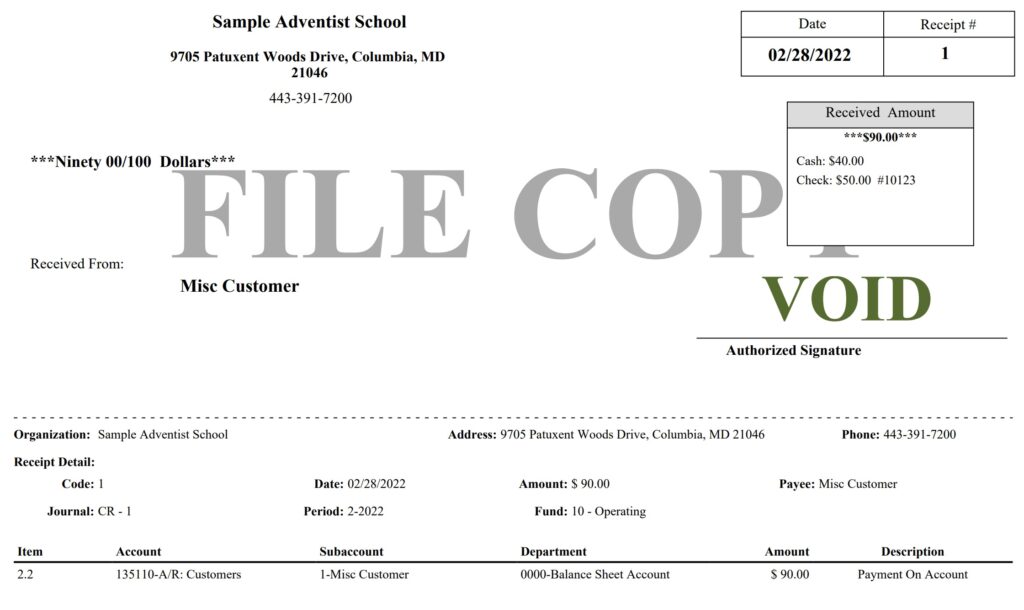
In Receive Money we can process payments received.
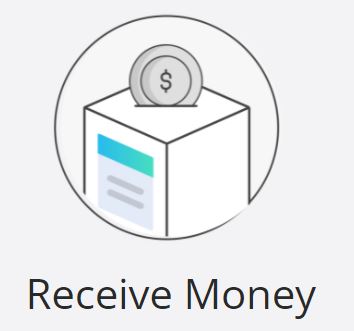
We will select the Received From (from a list of Customer, Employee, and Entity), populate the Receipt Date (this will be the transaction and Receipt Date), populate a mailing address (this address will print on the receipt), and description. The Receipt No. will auto populate for us when the receipt is issued and can be left blank, but we can also override this field to change the receipt number. We will also select the general ledger account to post to which would typically be an income account when we are receiving money (an account that starts with a 6xxxxx or 7xxxxx), the sub-account (breakdown within the account like a bank, entity, or project for example), department, populate a description (which can be the same as the Description at the top of the screen or it can be different if needed or if there are multiple entries), and amount. In the Payment section we will record the payment method used to receive money and this section can have one or multiple payments but the Total for this section must match the Total from the accounting entry Total before we are able to finalize our receipt and the Issue buttons at the bottom right of the screen will only become available until these two totals agree. In the Payment section we will select the payment method (from Cash, Check, Electronic, Other), populate the Reference (check number for example), and amount. The Save button after the amount saves the payment entry and Cancel will clear it. Once the payment entry is saved, there is a trash bin icon under the Actions column to delete the payment information. There is a Memo field towards the bottom of the screen that can be used to add an additional note. The “Issue Receipt and New” button will save the payment we are receiving and issue a receipt, close the receive money screen, and open a new Receive Money screen for us to issue a new receipt. The “Issue Receipt and Close” button will save the payment we are receiving and issue a receipt, close the receive money screen, and take us back into the main Receipt Management screen. The “Issue Receipt” button will issue the receipt but will leave the Receive Money screen open for the current receipt. The “Close” button will close out of the Receive Payment screen, but the system will prompt us before closing if we are sure we want to close the current window. In the “Other Actions” menu at the bottom of the screen, we will see options to View Journal Entry, Delete, Print, and Void. The View Journal Entry option will display the journal with the entries related to the receipt which are the debit to the receipt clearing account and credit to the income account. The Delete option will delete the current receipt entry and this option will only be available until the receipt is issued, once the receipt is issued, we won’t be able to delete and instead will need to void. The Print option will print a document for receive money (receipt). The Void option will allow us to void the receipt and will create additional entries for us to void, which will credit back into the receipt clearing account and debit the received amount into the income account. Once the payment received is saved, the system will save the receipt information, make entries to clear the receivable balance for the subaccount (credit entry to the accounts receivable account), and internally it will make the appropriate offsetting debit entry on our behalf to a clearing account (102200-Receipt Clearing for example). Additionally, the receipt entry created will be available in the Make Deposit screen from “Banking Transaction“. Reference Transaction Config and see the Journal Entry example below.
